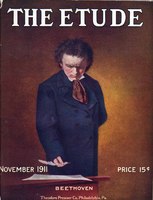A short time ago we met a dealer in costly tropical lumbers who sold most of his stock to the manufacturers of higher grade pianos. “There is one manufacturer,” he said, “who has the reputation of making what is considered by piano men and musicians one of the six best makes of pianofortes of to-day. This man is at the head of an old firm of piano makers whose instruments are known the world around. Most of my customers order their lumber, mahogany, rosewood, etc., by mail. This man employs a buyer who does nothing else but buy wood. The buyer comes to our storerooms personally and is often accompanied by his employer. He will spend hours, yes days, going over piles of lumber, inspecting each piece minutely, choosing the best and discarding the poorer pieces. He wants the best, the pick of the choicest, and he sees that he gets it and he is willing to pay more for it. When I remember that the same care and pains must be taken in all other departments I do not wonder that the instruments he turns out have won him international prestige.”
There is a fine idea in this for the teacher selecting teaching pieces. The selection of a good teaching piece is a matter of far more importance to the pupil than the kind of wood in which his piano is boxed. The right teaching piece at the right time may make a difference of several weeks in the child’s progress. The custom of rambling in a catalogue and then picking out a teaching piece at random is an unforgivable breach of musical pedagogical morals. The teacher should have each pupil’s course mapped out for weeks ahead. Some teachers know months ahead just what they expect to accomplish with each pupil. We remember how one of our teachers gave us a shop-worn copy of an obsolete piece by an unknown French composer at a time when we were literally “dying” for Mozart and Haydn. That piece was just like a stone wall. It stood in the way for months. There was no desire to break through its banal and meaningless tinklings. One of the best ways to tell a good teacher is to observe how much time and thought the teacher gives to selecting the right teaching piece.



